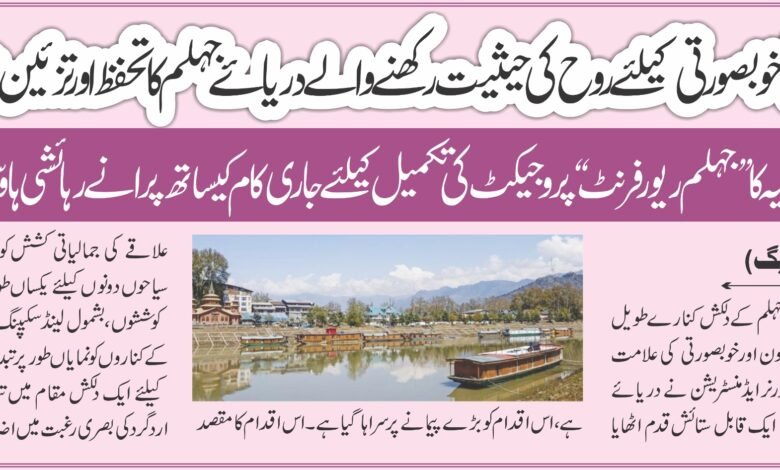“Revitalizing the Jhelum: Balancing Beauty and Heritage”

“Revitalizing the Jhelum: Balancing Beauty and Heritage”
“Transformative efforts along the Jhelum River demand preservation of cultural heritage and welfare of residents for sustainable development.”
Bashir Beigh
SRINAGAR: The protection and enhancement of the Jhelum River, a cherished element of Srinagar’s identity, stands as a crucial endeavor for preserving the natural allure of the city. Under the guidance of the Lieutenant Governor’s Administration, the ambitious “Jhelum Riverfront” project has garnered widespread acclaim for its efforts to enrich the scenic banks of the river. This initiative, aimed at elevating the aesthetic appeal of the area, has been met with enthusiastic support from both locals and tourists.

Through meticulous landscaping, creation of pedestrian pathways, and introduction of green spaces, significant strides have been made in revitalizing the Jhelum’s banks into idyllic spots for leisure and relaxation. Beyond mere visual enhancement, this initiative fosters community engagement and outdoor activities, enriching the fabric of neighborhood life.
However, amidst the celebration of this positive transformation, a pressing issue necessitates attention—the plight of the aging houseboats scattered along the Jhelum’s shores. These traditional dwellings, integral to the region’s cultural heritage, have fallen into disrepair, leaving many inhabitants in substandard living conditions. Urgent action is required to provide these residents with suitable alternative accommodations, ensuring their welfare while preserving the cultural significance of the houseboat lifestyle.
Sustaining the newfound beauty of the Jhelum’s banks demands ongoing maintenance efforts. Implementing regular cleaning campaigns, such as quarterly clean-up drives, is imperative to safeguard the riverbanks, mitigate pollution, and preserve the natural habitat. These initiatives not only enhance the area’s visual appeal but also instill a sense of environmental responsibility among residents and visitors alike.
While the restoration of the Jhelum’s banks serves to attract tourists and foster a more inclusive environment for the local community, it is essential for the administration to engage with stakeholders, environmentalists, and cultural experts. Collaborative efforts ensure that development plans are inclusive and respectful of the region’s rich heritage.
In conclusion, while the beautification endeavors along the Jhelum are commendable, long-term preservation necessitates addressing the challenges faced by houseboat residents and embracing sustainable practices. By striking a harmonious balance between development and conservation, the Lieutenant Governor’s Administration can establish the Jhelum as a beacon of responsible and inclusive urban planning, safeguarding its natural and cultural treasures for generations to come.





